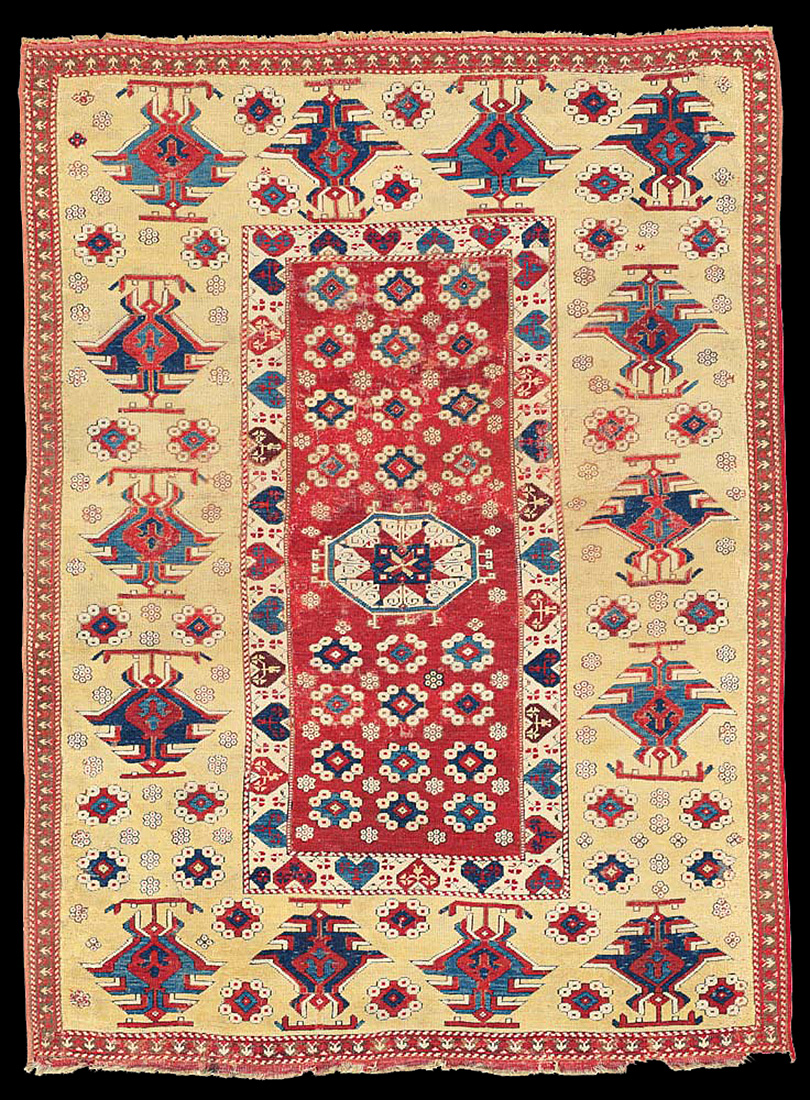|
THE VOLKMANN BERGAMA RUG
WEST ANATOLIA, LATE 17TH OR EARLY 18TH CENTURY
Price Realized £40,000 ($66,440)
Sale Information
Christies
SALE 1519 —
ORIENTAL RUGS & CARPETS
8 April 2014
London, King
Street
Lot Description
THE VOLKMANN
BERGAMA RUG
WEST ANATOLIA, LATE 17TH OR EARLY 18TH CENTURY
Uneven
wear, corroded brown, areas of repair
7ft.2in. x 5ft.4in. (218cm. x
163cm.)
Literature
Friedrich
Spuhler, Hans Konig and Martin Volkmann, Old Eastern Carpets: Masterpieces
in German Private Collections, Munich, 1978, pl.21, pp.70-71.
Hali 161,
Letters, p.19
Exhibited
Alte Orientteppiche, Staatliche Museum für
Völkerkunde, Munich, 1978
Lot Notes
This beautiful village
rug is a fascinating weaving that combines sophisticated court workshop
design with archaic inherited motifs. The central octagonal medallion is
taken almost directly from large pattern Holbein medallions while the bold
stepped shield medallions and floral rosettes derive from the tradition of
village weaving. It is one of a very small group of rare 17th or 18th
century Anatolian weavings with unusually wide borders of dynamic
alternating shield palmettes and narrow field panels of repeating
rosettes.
Only two examples of the present design are known. Our
carpet relates very closely to an example in the Metropolitan Museum of
Art, New York, formerly in the collection of Joseph V. McMullan, inv. no.
1974.149.37. Writing about his rug McMullan states ‘Occasionally a rug
appears which is so exciting in design as to find a definite place in
almost any rug collection.’ (Joseph V. McMullan, Islamic Carpets, New
York, 1965, pl.114, pp.332-333). These two rugs must have been woven
within close proximity due to the similarity of nearly every design
element, from the scale of the shield palmettes right down to the
idiosyncracies of the heart minor stripe. However, there are a number of
weaving irregularities on the McMullan rug where the design appears
interrupted. The drawing of our rug is more elegant, assured and better
resolved by the weaver.
There are two other related rugs with
central Holbein medallions, a rug sold at Rippon Boswell, Wiesbaden, 20
May 2006, lot 97 and the rug illustrated in Peter Bausback, Antike
Orientteppiche, Brauschweig, 1978, p.83, which has the same charming heart
stripe but with a more normal field to border ratio and lacks the bold
shield medallions which make the present example and the McMullan rug so
striking. The other branch of this small group have related shield
medallions in their borders but they have jointed legs which give them a
beetle-like quality. This group consists of the rug gifted by the estate
of Colonel Michael Friedsam to the Brooklyn Museum, inv. no. 32.548
(Heinrich Jacoby, Eine Sammlung Orientalischer Teppiche, Leipzig, 1923,
p.91, pl.25), a rug published by Eberhart Herrmann (Seltene Orientteppiche
X, Munich, 1988, pl.16, p.44-45), and one sold in these Rooms, 5 April
2011, lot 217.
It is testimony to the beauty of this rug that it
appears in the background of the photograph of Martin Volkmann
accompanying Hans Konig’s memorial tribute to the great carpet enthusiast
in Hali 161.
|

